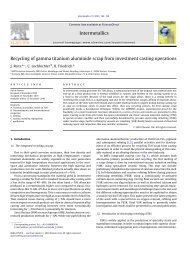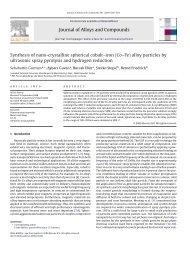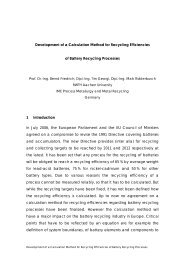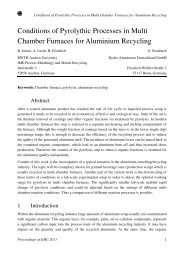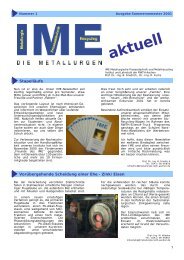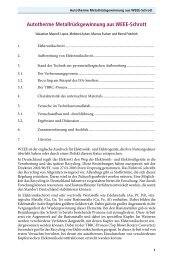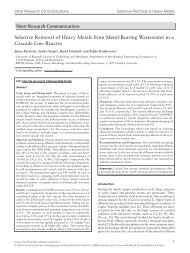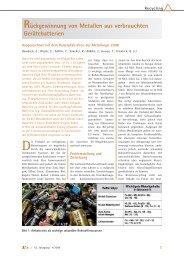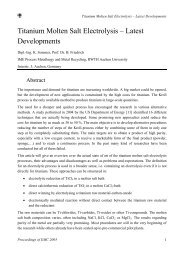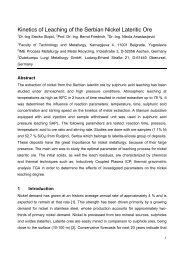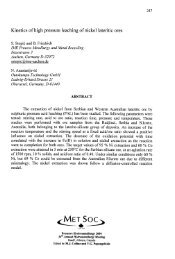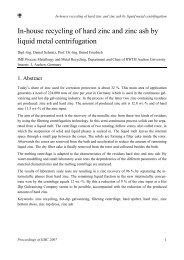Atmospheric leaching of EAF dust with diluted sulphuric acid
Atmospheric leaching of EAF dust with diluted sulphuric acid
Atmospheric leaching of EAF dust with diluted sulphuric acid
- No tags were found...
You also want an ePaper? Increase the reach of your titles
YUMPU automatically turns print PDFs into web optimized ePapers that Google loves.
T. Havlik et al. / Hydrometallurgy 77 (2005) 41–50 47a40b40Ca extraction [%]302010t = 20 • C; C H2S04 = 0.4 Ma/d = 1.2a/d = 0.6a/d = 0.4Ca extraction [%]302010a/d = 1.2a/d = 0.6a/d = 0.4cCa extraction [%]00 10 20 30 40 50 60 70Leaching time [min]40302010a/d = 1.2a/d = 0.6a/d = 0.4dCa extraction [%]t = 40 • C; C H2S04 = 0.4 M00 10 20 30 40 50 60 7040302010Leaching time [min]t = 80 • C; C H2S04 = 0.4 Ma/d = 1.2a/d = 0.6a/d = 0.4t = 60 • C; C H2S04 = 0.4 M00 20 40 60Leaching time [min]00 10 20 30 40 50 60 70Leaching time [min]Fig. 7. (a) Extraction <strong>of</strong> Ca by <strong>sulphuric</strong> <strong>acid</strong> at a temperature <strong>of</strong> 20 8C. (b) Extraction <strong>of</strong> Ca by <strong>sulphuric</strong> <strong>acid</strong> at a temperature <strong>of</strong> 40 8C. (c)Extraction <strong>of</strong> Ca by <strong>sulphuric</strong> <strong>acid</strong> at a temperature <strong>of</strong> 60 8C. (d) Extraction <strong>of</strong> Ca by <strong>sulphuric</strong> <strong>acid</strong> at a temperature <strong>of</strong> 80 8C.Although the amount <strong>of</strong> dissolved calcium is ratherhigh, it is considerably decreased by the increase <strong>of</strong>the charge, as it is demonstrated in Fig. 8a toc.The concentration <strong>of</strong> H 2 SO 4 used for these experiments,i.e. 0.4 mold dm 3 , results from previousexperiments described in study (Havlik et al., 2004).The thermodynamic considerations and calculationsreveal that this concentration should mostly be spentfor the dissolution <strong>of</strong> zinc, but less for iron andcalcium. Fig. 9 shows the <strong>acid</strong> consumption during<strong>leaching</strong>, determined as the dependence <strong>of</strong> the pHvalueon the charge amount at various temperatures.The results reveal that the a/d ratio, i.e. the chargeamount, plays an important role in the metalextraction. pH values were increased according tothe increase <strong>of</strong> the a/d ratio due to a higherconsumption <strong>of</strong> <strong>sulphuric</strong> <strong>acid</strong> during <strong>leaching</strong>. Sincesmall charges are used, the zinc extraction is considerablyhigh. The maximum value for zinc extractiona=67% is obtained at a temperature <strong>of</strong> 80 8C, in a time<strong>of</strong> 60 min and at a used concentration <strong>of</strong> <strong>sulphuric</strong><strong>acid</strong> <strong>of</strong> 0.4 mold dm 3 , Figs. 3d and 4a. A furtherincrease <strong>of</strong> the <strong>leaching</strong> time would probably result insame zinc extraction increasing as follows from Figs.3d and 4a.The increase <strong>of</strong> the charge amount results in thedecreasing <strong>of</strong> the zinc extraction. In these cases,however, temperature plays a less important role. Thisprobably means that the <strong>sulphuric</strong> <strong>acid</strong> concentrationis a limiting factor for the dissolution <strong>of</strong> zinc.This applies to iron and calcium, too. Themaximum <strong>of</strong> iron dissolved is less than 10%, (Figs.5d and 6a), but in case <strong>of</strong> calcium it is up to 40%(Figs. 7d and 8a).Comparing <strong>of</strong> the results obtained in this work <strong>with</strong>those obtained in the study <strong>of</strong> high temperature/



